Cherry blossoms are in season and the ancient Japanese capital of Nara, with its majestic Todaiji “Big Buddha” temple and its herds of deer, would normally be packed.
This year, it's almost deserted, as are most other tourist attractions in Japan as foreign visitors stay away and locals heed warnings to stay home to try to contain the spread of the coronavirus.
The tourism industry, heavily reliant on foreign travelers, has taken a beating since Beijing banned group tours in late January. But there's a silver lining for some Japanese living in popular locations like Kyoto who were getting fed up with the crowds and disruptions from legions of visitors.
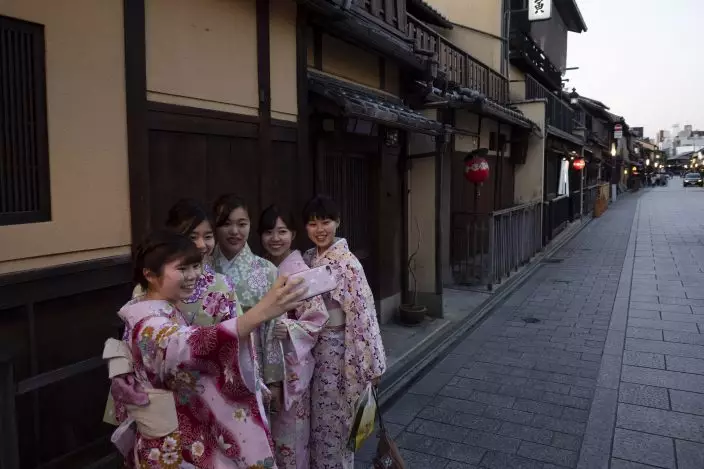
A group of Japanese women wearing kimono takes a selfie in the Gion district of Kyoto, Japan on March 18, 2020. Japanese tourism industry has taken a beating after Beijing banned group tours in late January. (AP PhotoJae C. Hong)
Tadayuki Takiguchi's souvenir shop was the only one open on a recent weekday on a street near Nara's famous deer park, where tourists usually stop to take photos and feed the animals.
“Sometimes I don't see anyone on the street,” Takiguchi said. “I've never seen anything like this.”
Nara was among the first Japanese towns to be hit by the virus outbreak when a local bus driver tested positive for the virus in late January after carrying tourists from Wuhan, the epicenter of the pandemic. Around the same time, China's government banned group tours and sales of overseas travel packages.
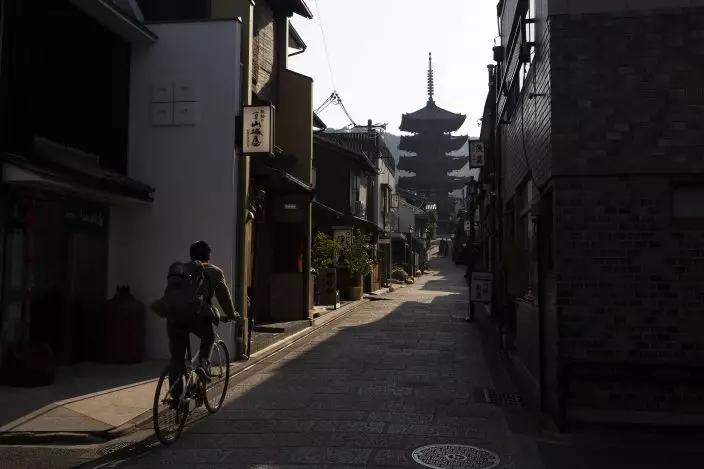
A man rides his bike toward Yasaka Pagoda in the Higashiyama district of Kyoto, Japan, March 19, 2020. Kyoto's city government has an emergency fund for small to medium-size businesses who suffered sharp sales decline since the coronavirus outbreak. (AP PhotoJae C. Hong)
Chinese tourists quickly disappeared, followed by visitors from the U.S. and Europe, Takiguchi said. These days, most shops don't bother to open, some perhaps wary of customers who might spread the virus.
As of Sunday, Japan had reported more than 2,400 confirmed cases of the virus, including 712 infected while being quarantined on a cruise ship. Authorities have ordered some school closures and advised people in areas such as Tokyo, where the number of cases is growing quickly, to try to stay home.
Widening travel restrictions and closures of most tourism and entertainment venues have gutted the tourism industry in many parts of the world, as well as in Japan.
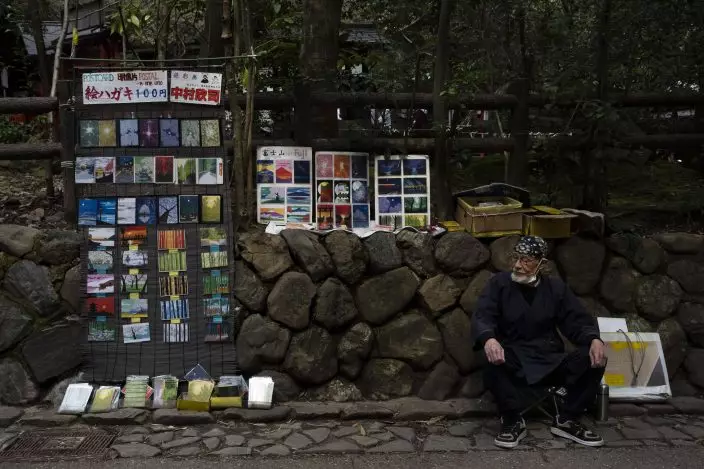
Artist Kinji Kimura, 76, who sells postcard-sized prints of work, sits on a stool while waiting for customers near the Arashiyama Bamboo Forest in Kyoto, Japan, March 18, 2020. "Arashiyama is empty," is a new catchphrase that appeared on posters in the area. "It's time to visit Kyoto," they say, because there are no long lines and waiting to do river rafting, get into popular temples or cross the bridge. (AP PhotoJae C. Hong)
With virtually no customers, Takiguchi says his business is “doomed."
But some see a bright side to the unusual quiet in places that in the past few years have been inundated with visitors.
In nearby Kyoto, officials and residents are considering how to make tourism more sustainable.
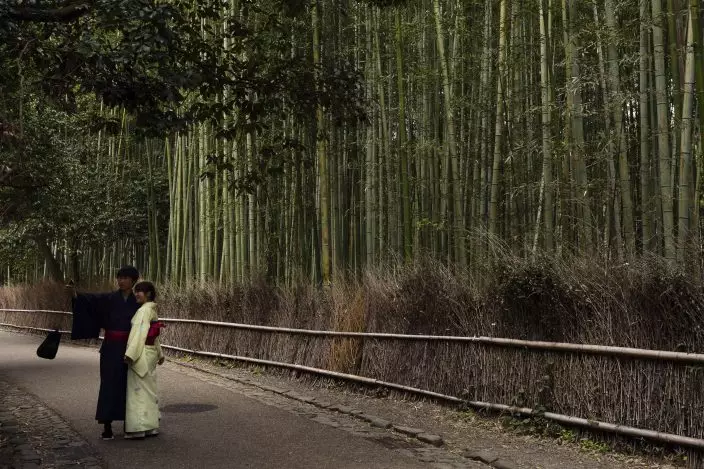
A couple takes a selfie at the Arashiyama Bamboo Forest in Kyoto, Japan, March 18, 2020. Widening travel restrictions and closures of most tourism and entertainment venues have gutted the tourism industry in many parts of the world, as well as in Japan.(AP PhotoJae C. Hong)
“I feel Kyoto's ‘wabi-sabi’ atmosphere is back,” said freelance tour guide Takakazu Machi, referring to traditional aesthetic sensibilities of simplicity and beauty evoked in the world of Haiku.
Machi, left with no income during what should be the peak sakura season, is driving a cab to make ends meet.
Artist Kinji Nakamura, 76, who lives near the scenic Togetsu bridge in Kyoto's verdant Arashiyama district, had grown weary of the traffic jams and nuisance caused by some tourists, who have for example have had to be warned against climbing inside ancient, fragile cherry trees to take selfies.
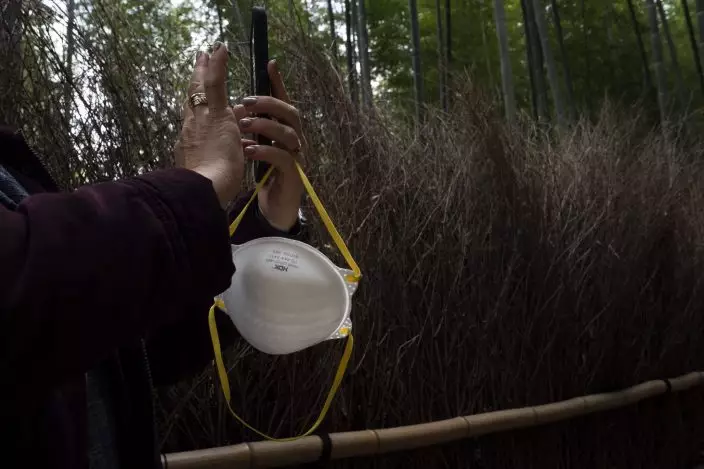
A tourist holds a mask while taking pictures of the Arashiyama Bamboo Forest in Kyoto, Japan, March 18, 2020. (AP PhotoJae C. Hong)
“Tourists were overflowing, and this is about right,” Nakamura said.
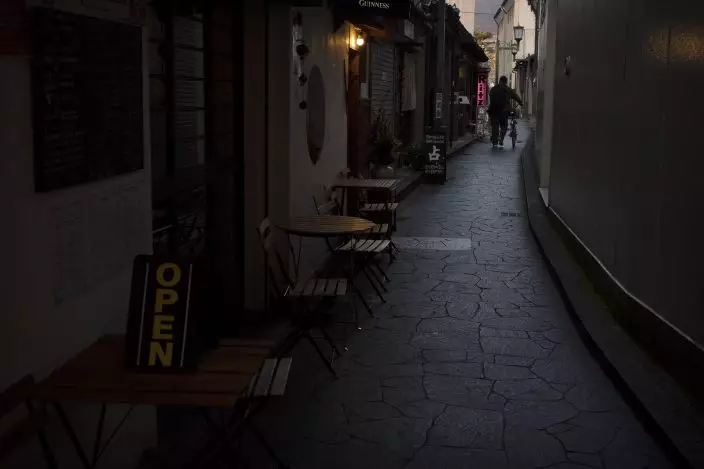
A man walks with his bike through a narrow alley lined with restaurants in Nara, Japan, Tuesday, March 17, 2020. (AP PhotoJae C. Hong)
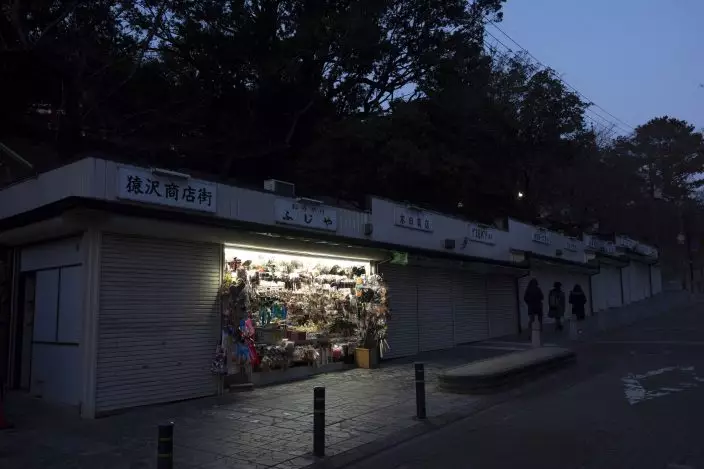
Tadayuki Takiguchi's souvenir shop remains open in Nara, Japan, March 17, 2020. Nara was among the first Japanese town hit by the COVID-19 in late January, when a tour bus driver in town tested positive for the virus, becoming the first Japanese patient after carrying tourists from Wuhan, the epicenter of the pandemic. (AP PhotoJae C. Hong)

A man is silhouetted while sitting in a train bound for Nara at Kyoto Station in Kyoto, Japan on March 17, 2020. (AP PhotoJae C. Hong)
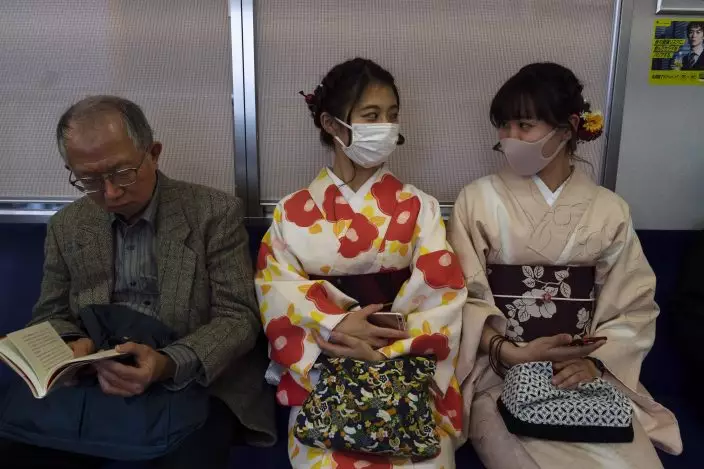
Two women wearing kimono chat in a train in Kyoto, Japan, March 18, 2020. Japanese tourism industry has taken a beating after Beijing banned group tours in late January. Japan's government restricted entry from China and South Korea in early March, then expanded the measures to parts of Europe. (AP PhotoJae C. Hong)
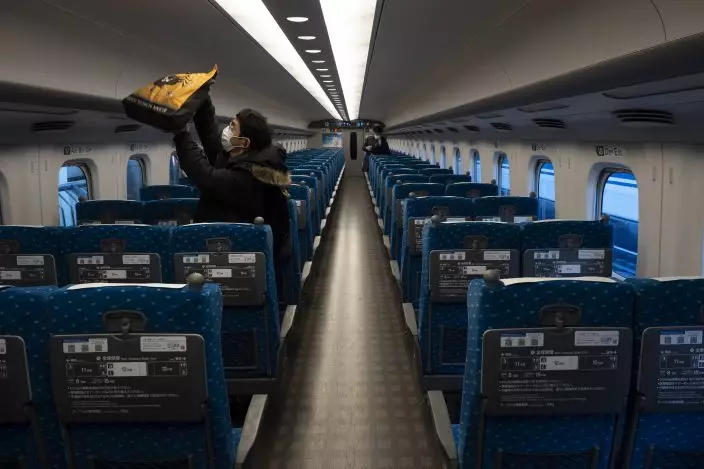
A traveler places his bag in an overhead luggage rack in a bullet train bound for Kyoto and Osaka at Tokyo Station in Tokyo, March 17, 2020. (AP PhotoJae C. Hong)

A tourist walks past shoe racks provided for visitors at Tenryuji Temple in the Arashiyama district of Kyoto, Japan, March 18, 2020. "Arashiyama is empty," is a new catchphrase that appeared on posters in the area. "It's time to visit Kyoto," they say, because there are no long lines and waiting to do river rafting, get into popular temples or cross the bridge. (AP PhotoJae C. Hong)

Tourists pause for photos in front of Todaiji temple's main hall in Nara, Japan, March 17, 2020. Nara was among the first Japanese town hit by the COVID-19 in late January, when a tour bus driver in town tested positive for the virus, becoming the first Japanese patient after carrying tourists from Wuhan, the epicenter of the pandemic. (AP PhotoJae C. Hong)
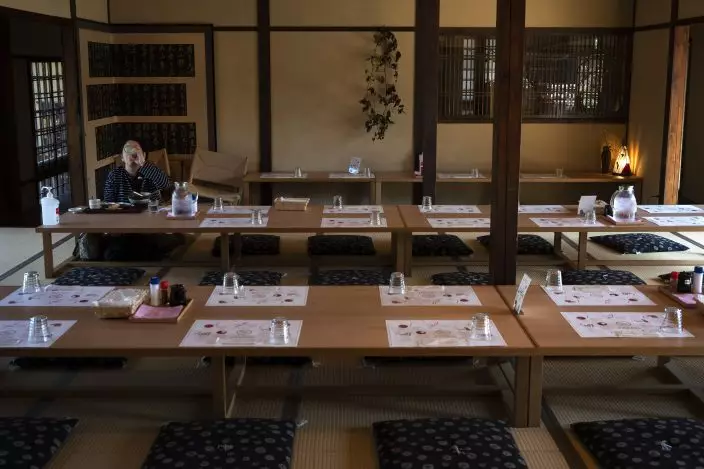
A tourist eat her lunch in a restaurant in Nara, Japan, March 19, 2020. Nara was among the first Japanese town hit by the COVID-19 in late January, when a tour bus driver in town tested positive for the virus, becoming the first Japanese patient after carrying tourists from Wuhan, the epicenter of the pandemic. (AP PhotoJae C. Hong)
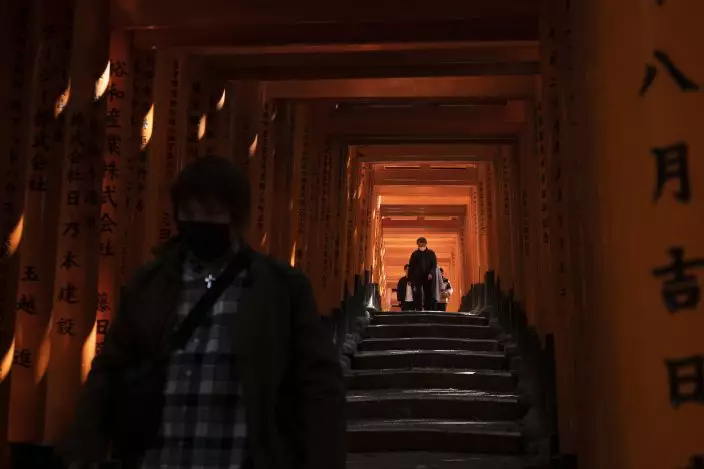
Tourists walk through torii gates at Fushimi Inari Shrine in Kyoto, Japan, March 18, 2020. Japanese tourism industry has taken a beating after Beijing banned group tours in late January. (AP PhotoJae C. Hong)
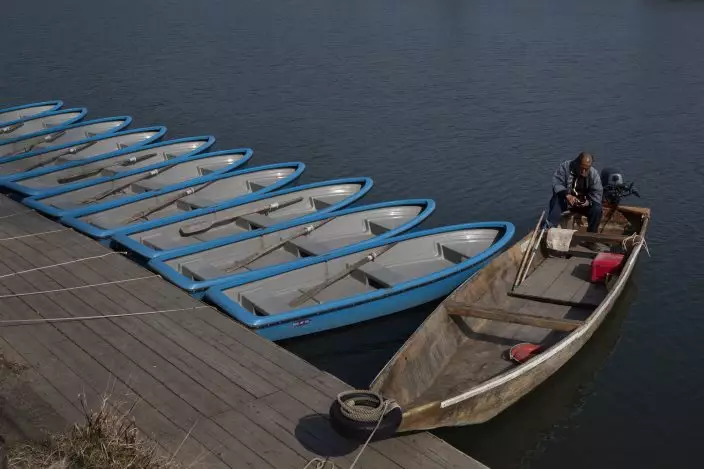
A ferryman sits in his boat while waiting for tourists in the Arashiyama district of Kyoto, Japan, March 18, 2020. (AP PhotoJae C. Hong)
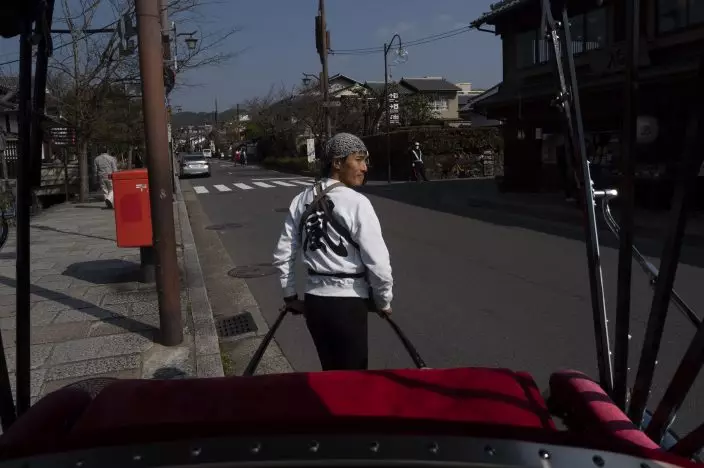
A rickshaw puller crosses the street in the Arashiyama district of Kyoto, Japan, March 18, 2020. (AP PhotoJae C. Hong)
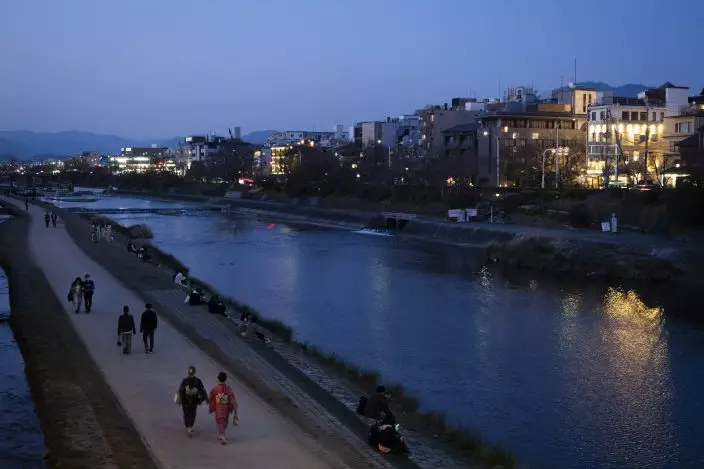
People stroll along the Kamo River in Kyoto, Japan, March 18, 2020. Kyoto's city government has an emergency fund for small to medium-size businesses who suffered sharp sales decline since the coronavirus outbreak. (AP PhotoJae C. Hong)


